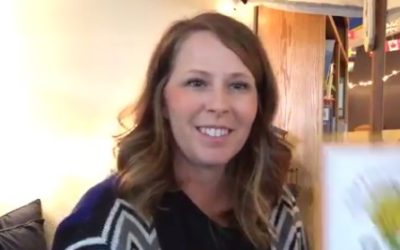How to Give a Good Speech & What to Look for in Student Presentations
Katlyn Avritt | Oxford Senior High | Oxford, Kansas
Giving a speech is a vital part of being a teacher and student. Knowing how to give a proper presentation is key.
Read Transcript
The idea of giving a public speech is something that makes a lot of people nervous. Public speaking beats out most other top reported fears. Including spiders, snakes, and flying. I teach high-school language arts, drama and speech. And being able to present a good speech is one of the most crucial skills that employers and colleges are looking for as students leave high school. Communication is what allows us to form connections with other people, to inspire change and to teach, which is what leads to progress. Yet often, I encounter students who are incredibly nervous about actually getting up there and giving a speech, or giving a presentation in front of people. And there are few tips that I like to go over with those students to help them calm down and increase their confidence, when they’re going out there to give a speech. And so, the top thing that I like to focus on is having students be prepared. I like to break that down into two different areas of preparation. Preparing their content, and then preparing themselves for delivering their speech. So, the first thing I want to talk about is preparing their content. Okay, if you have a strong content, if you feel knowledgeable, and have done your research in what it is your talking about, that’s going to come across in how your speaking, and it’s going to make you a more confident speaker. So, you need to make sure that your students have done their research thoroughly, and then guide them through a logical outline, which will help them remember what their speech is going to be. But the one thing that I stress in the terms of content, is what I call the power areas. Having these three strong power areas is really going to help them make a large impact on their audience in a short amount of words. So, the three power areas that I want to talk about, is having a really strong hook, having a strong thesis statement, and having a strong closing line. The students hook is going to be their opening line for the speech. And, it’s really important to have that be strong because they want their audience to be engaged from very beginning. Having an audience that’s listening to what you’re saying, that’s active, that’s nodding is going to increase your confidence as a speaker. And what I would suggest if a student’s particularly nervous is to use a joke, or a funny story as their hook. It’s going to cause the audience to laugh and hopefully it’s going to make you as the speaker to laugh. Which is going to relax the mood in the room. It’s going to relax the speaker, and people like to laugh. They like to be happy. So, it’s going to create an instant bond between the speaker and their audience. The next area that’s really important, to make sure its strong, and well prepared is going to be the thesis statement. Thesis statements should come at the very end of your introduction. It’s going to set up what your topic is, and how you’re going to prove it. It provides a framework for the audience, so that they know what to expect for the rest of the speech. Typically, what I advise students to do, is they give whatever claim they’re going to be making, and three to five reasons. Okay, so I believe blank, and I’ll show this to you by one. Secondly, by doing this, and finally, by doing this. That’s going to set up a map so that the audience knows what to expect in the coming speech. The third power area that I want to talk about is the closing line. Having a powerful closing line is really crucial because, that last line is what the audience leaves remembering. It gives you as the speaker one last opportunity to kind of go over with your audience what your message and what purpose of your speech is going to be. You need to make sure that your students carefully plan out that closing line. So that there not standing up there at the end of the speech not really sure how they should end. Thinking, “Um, well thank you guys, I’m done.” Okay, make sure that they end with a bang. That they leave the audience leaving the speech and thinking about it for hours, and days afterward. Okay so, once you’ve kind of helped solidify their content, you can move on to helping your students prepare themselves for the speech. And, there’s a lot of different areas and ways to do this. But, the two I want to talk about are, help your students be poised, and be positive about the speech. If they have good poise hopefully this will transfer into the other areas of the speech. So, under poise you want to talk about feeling confident in what your presenting. So, you want to make sure that your students dress for success, and that the image that they’re presenting of themselves is one that they’re happy with. That they go out there feeling confident. Also, under that, is going to be posture. Having a strong posture, walking in there with your head held high, and your shoulders back, is going to make you look more confident, and sound more confident. Which hopefully will in turn make you feel more confident. Also under poise is smiling. Okay, studies have shown that smiling will actually increase your mood. So even if your nervous putting on a smile is going to make you feel better, and again it’s going to help you relate with your audience. You want to look out into the crowd smile at them and keep that smile going when it’s appropriate throughout that speech. Along with smiling you want to make sure that you’re positive, and passionate about what it is your talking about. When you’re giving a speech, you want to try to engage the audience. And how can you expect for your audience to be interested in what you’re saying if you’re not even showing that you’re interested in it yourself. So, you want to make sure that whatever your enthusiastic about with your speech that you let that shine through. Ideally your students are speaking about something which they are excited to talk about, their excited to share their knowledge with their audience. Encourage them to let that enthusiasm and excitement shine through in their speaking. So, I teach that the key to successful public speaking is in proper preparation. Students need to make sure that they prepare their content, through thorough research organization and making sure they have really strong power areas. And in preparing themselves in regards, to poise and making sure that they’re bringing a positive attitude to the speech. These skills are really going to help increase confidence when they’re speaking, and hopefully lead to more confident speeches. So, I believe that everyone has, the ability to, walkout in front of an audience with their head held high, shoulders back, a smile on their face, and give the best speech of their life. If, they put some attention into the preparation I talked about today, hopefully these skills will be able to come out in your students.
Help teachers and children
worldwide by sharing how
you teach.
A global movement of people sharing knowledge and learning from each other, to better educate our children and create hope for the world.
A global movement of people sharing knowledge and learning from each other, to better educate our children and create hope for the world.






